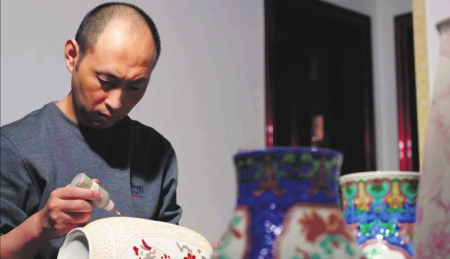Ancient handicraft gets new lease on life

Zhen Shisheng applies enamel to a piece of fahua ware at his studio in Yangquan.Li Lian / For China Daily
Zhen Shisheng, a resident in the eastern Shanxi city of Yangquan, is a man with hearing loss and speech difficulties.
He began to suffer from hearing loss after a medication error when he was 3 years old, followed by speech difficulties in the following years.
Despite his physical difficulties, Zhen has lived a meaningful life, thanks to his interest and talent in and enthusiasm for the traditional Shanxi art of fahua ware.
Fahua ware, which is mostly made in the south and east of Shanxi, is the porcelain version of cloisonne, where the design elements are separated by copper wires. Porcelain featuring these techniques is fired at lower temperatures with the different colored glazes and enamels applied to individual areas created by the slip lines.
When recalling his experience to learn the techniques to make this Shanxi handicraft with a history of hundreds of years, he said it was his difficulties in hearing and speech that made him concentrate on something he loves.
"When you lose some abilities, you would cherish all the others left to you," Zhen said in sign language. "Success is possible when you apply all your senses and abilities to your subject of work."
Zhen learned the craft from his father, who is a master fahua ware craftsman in a porcelain factory in Yangquan.
He said the hardest part of learning to make fahua ware is that the fahua techniques have been lost for about 300 years, and today's revival of the art has been made through artists' painstaking research into ancient documents and existing museum exhibits, as well as their own imagination.
"But it has proven to be a blessing in disguise," Zhen said. "Despite the ancient documents and exhibits used as a frame of reference, this is almost a brand-new art form for today's craftsmen," Zhen said. "This means you can fully embrace your creativity."
Zhen's creativity and innovation in this art are demonstrated in the freedom of using lines and glaze colors, as well as the selection of patterns and images for decoration.
For instance, one of his award-winning works features the figures of A Dream of Red Mansions, one of the four great Chinese classical novels. This piece of work is also different from the antiques with its smoother lines and brighter colors.
Zhen opened a fahua training studio in a middle school in the suburbs of Yangquan, which has trained more than 500 students over the past few years.
"I'm happy to see a growing enthusiasm among the young people," Zhen said. "I believe this cultural heritage can be passed down to generations in the future."
Li Lian contributed to this story.
By Yuan Shenggao











